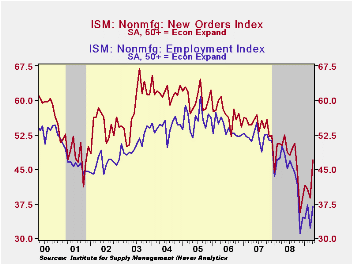 Global| May 05 2009
Global| May 05 2009U.S. ISM Nonmanufacturing Index Recovers To Highest Level Since October
by:Tom Moeller
|in:Economy in Brief
Summary
The service sector recovered its earlier losses last month. The April Composite Index for the nonmanufacturing sector from the Institute for Supply Management (ISM) rose to 43.7 last month from an unrevised reading of 40.8 during [...]

The service sector recovered its earlier losses last month. The April Composite Index for the nonmanufacturing sector from the Institute for Supply Management (ISM) rose to 43.7 last month from an unrevised reading of 40.8 during March. The latest was the highest level since October of last year and it was higher than Consensus expectations for a reading of 42.0. A level of the ISM index below 50 indicates declining activity. Since the series' inception in 1997 there has been a 48% correlation between the level of the business activity index in the nonmanufacturing sector and the Q/Q change in real GDP for the services and the construction sectors.
Improved new orders led last month's gain in the overall ISM index. The orders index rose by nearly ten points from March to the highest level since the Fall. An index which measures the speed of vendor deliveries continued to suggest slack and fell sharply to its lowest level in the series' history which dates back to 1997.
The business activity sub-index also rose further last month to its highest level since last September. That rise came as the employment index made up its March decline and settled near its highest level in six months. Since the series' inception in 1997 there has been a 56% correlation between the level of the ISM nonmanufacturing employment index and the m/m change in payroll employment in the service-producing plus the construction industries.
Pricing power continued under pressure. Though the price index ticked up slightly from March, it remained near its lowest level. Since its inception ten years ago, there has been a 60% correlation between the price index and the q/q change in the GDP services chain price index.Beginning with the January 2008 Nonmanufacturing Report On Business®, the composite index is calculated as an indicator of the overall economic condition for the non-manufacturing sector. It is a composite index based on the diffusion indices for four of the indicators (business activity, new orders, employment and supplier deliveries) with equal weights. The latest report from the ISM can be found here.
ISM surveys more than 370 purchasing managers in more than 62 industries including law firms, hospitals, government and retailers. The nonmanufacturing survey dates back to July 1997.
Today's testimony by Fed Chairman Ben S. Bernanke titled The Economic Outlook can be found here.
| ISM Nonmanufacturing Survey | April | March | April '08 | 2008 | 2007 | 2006 |
|---|---|---|---|---|---|---|
| Composite Index | 43.7 | 40.8 | 51.9 | 47.4 | 53.5 | 55.7 |
| Prices Index | 40.0 | 39.1 | 72.2 | 66.0 | 63.8 | 65.3 |
Tom Moeller
AuthorMore in Author Profile »Prior to joining Haver Analytics in 2000, Mr. Moeller worked as the Economist at Chancellor Capital Management from 1985 to 1999. There, he developed comprehensive economic forecasts and interpreted economic data for equity and fixed income portfolio managers. Also at Chancellor, Mr. Moeller worked as an equity analyst and was responsible for researching and rating companies in the economically sensitive automobile and housing industries for investment in Chancellor’s equity portfolio. Prior to joining Chancellor, Mr. Moeller was an Economist at Citibank from 1979 to 1984. He also analyzed pricing behavior in the metals industry for the Council on Wage and Price Stability in Washington, D.C. In 1999, Mr. Moeller received the award for most accurate forecast from the Forecasters' Club of New York. From 1990 to 1992 he was President of the New York Association for Business Economists. Mr. Moeller earned an M.B.A. in Finance from Fordham University, where he graduated in 1987. He holds a Bachelor of Arts in Economics from George Washington University.






